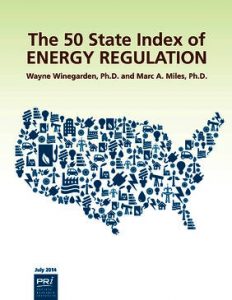The 50 State Index of Energy Regulation measures the regulatory climate for energy consumption, production, and distribution and which states are more economically efficient. Alabama, Alaska, South Dakota, and Texas tied for the best (#1), while California (#49) and New York (#50) are at the bottom. The Energy Index was authored by PRI senior fellows Wayne Winegarden, Ph.D. and Mark A. Miles, Ph.D.

As economists, we have adopted a basic economic perspectiveeconomic efficiencydefined as allocating resources to their most productive uses, said Dr. Winegarden. The effects of policies are evaluated, as objectively as possible, solely from that perspective. Policies that promote economic efficiency receive higher scores, those that reduce economic efficiency receive lower scores.
Examining the regulatory variation across states determines where in the country the regulatory environment is optimal. This economic efficiency approach supplies a useful perspective on state energy regulations, added Dr. Miles. It also provides an important contribution to uncovering what data exist for defining and measuring the relative regulatory implications across the states.
Based on seven component indices or sets of questions that form the core of the Index scoring and rankings, states that have a score of 1 means a states energy regulatory environment is relatively economically efficient and 10 means a relatively inefficient economic environment.
Numerous patterns emerge from the Index. First, there is little relationship between whether a state has substantial energy resources like oil, gas, and coal, and whether its regulations are economically efficient. Size of the state and amount of energy production do not affect ranking.
Additionally, a geographical configuration shows that states on the West Coast, in the Northeast, and in the upper Midwest have the most economically inefficient energy regulations. States in the South and the center of the country have regulatory environments more favorable to efficient allocation in production and consumption of energy.
Lastly, the direct relationship between a states ranking and its economic growth rate are well connected. On average, high ranked states grow faster than those ranked low. Furthermore, the higher rate of economic growth is associated with faster employment growth.
According to Dr. Winegarden, This relationship makes sense. Energy is one of the essential ingredients that drive economic growth in a modern economy. Consequently, states that encourage the efficient production and consumption of energy should be expected to experience faster economic growth than those states that discourage economic efficiency in the energy marketplace.
Read the Study
Read the Executive Summary
Check out the Interactive Map
50 State Index Of Energy Regulation
Wayne Winegarden
The 50 State Index of Energy Regulation measures the regulatory climate for energy consumption, production, and distribution and which states are more economically efficient. Alabama, Alaska, South Dakota, and Texas tied for the best (#1), while California (#49) and New York (#50) are at the bottom. The Energy Index was authored by PRI senior fellows Wayne Winegarden, Ph.D. and Mark A. Miles, Ph.D.
As economists, we have adopted a basic economic perspectiveeconomic efficiencydefined as allocating resources to their most productive uses, said Dr. Winegarden. The effects of policies are evaluated, as objectively as possible, solely from that perspective. Policies that promote economic efficiency receive higher scores, those that reduce economic efficiency receive lower scores.
Examining the regulatory variation across states determines where in the country the regulatory environment is optimal. This economic efficiency approach supplies a useful perspective on state energy regulations, added Dr. Miles. It also provides an important contribution to uncovering what data exist for defining and measuring the relative regulatory implications across the states.
Based on seven component indices or sets of questions that form the core of the Index scoring and rankings, states that have a score of 1 means a states energy regulatory environment is relatively economically efficient and 10 means a relatively inefficient economic environment.
Numerous patterns emerge from the Index. First, there is little relationship between whether a state has substantial energy resources like oil, gas, and coal, and whether its regulations are economically efficient. Size of the state and amount of energy production do not affect ranking.
Additionally, a geographical configuration shows that states on the West Coast, in the Northeast, and in the upper Midwest have the most economically inefficient energy regulations. States in the South and the center of the country have regulatory environments more favorable to efficient allocation in production and consumption of energy.
Lastly, the direct relationship between a states ranking and its economic growth rate are well connected. On average, high ranked states grow faster than those ranked low. Furthermore, the higher rate of economic growth is associated with faster employment growth.
According to Dr. Winegarden, This relationship makes sense. Energy is one of the essential ingredients that drive economic growth in a modern economy. Consequently, states that encourage the efficient production and consumption of energy should be expected to experience faster economic growth than those states that discourage economic efficiency in the energy marketplace.
Read the Study
Read the Executive Summary
Check out the Interactive Map
Nothing contained in this blog is to be construed as necessarily reflecting the views of the Pacific Research Institute or as an attempt to thwart or aid the passage of any legislation.
Subscribe to our newsletter: